Features of Japanese kerriya and its cultivation
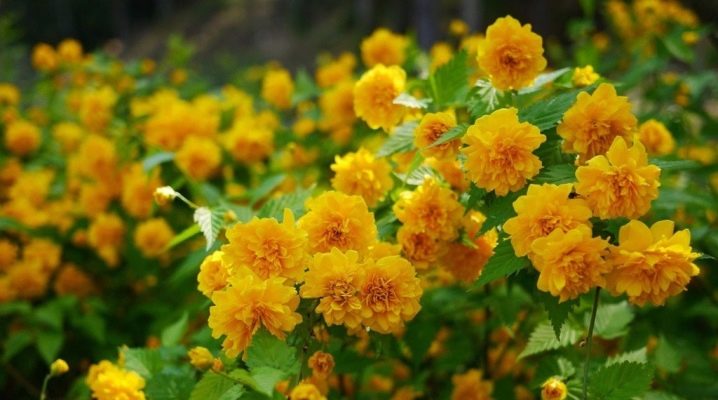
Kerria japonica is a perennial shrub tree from the Pink family. The homeland of this plant is the southwestern territories of China and Japan, in our country it is widely used for landscaping squares, parks and gardens. At the same time, it is very important to properly care for the culture, taking into account the natural and climatic characteristics of the region.
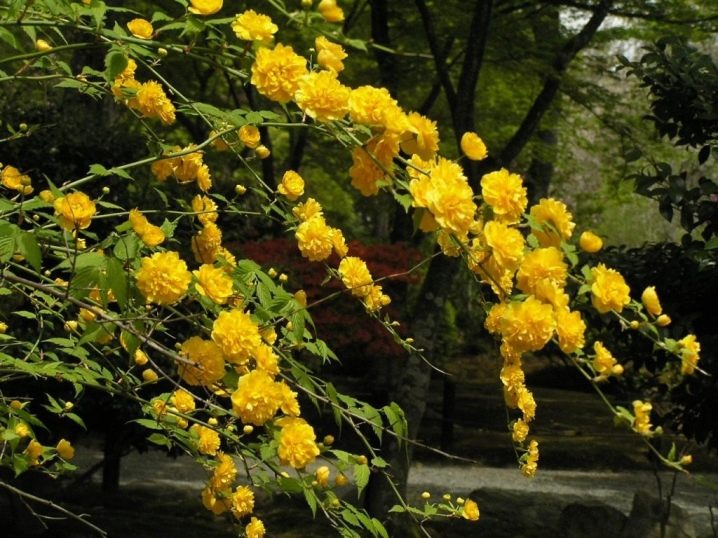
Description
The shrub got its name in honor of the first Ceylon botanist and famous plant collector W. Kerr. This plant is popularly known as the "Easter rose". Such an unusual nickname is due to the fact that its flowers look like a pink bud, and the flowering itself begins on one of the most important holidays for all Christians. Kerria japonica has a high growth rate and, in comfortable conditions, reaches a height of 3 m.
The culture is very popular for its lush flowering, stretched out in time, on average it lasts about 3-5 weeks.
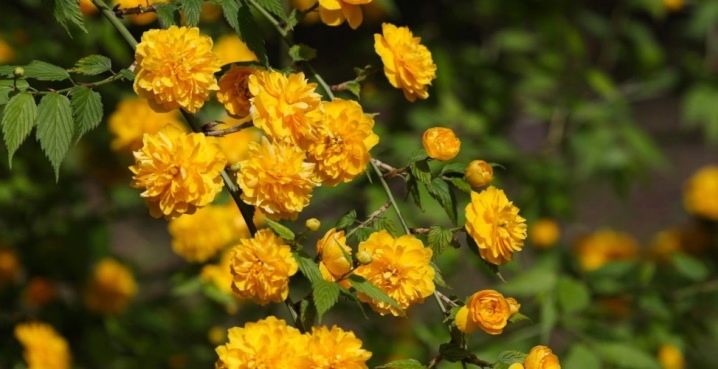
Depending on weather factors, the flowering duration of this exotic bush can vary: decrease or, on the contrary, increase. In favorable conditions, kerria bushes can bloom twice. Despite the fact that the re-flowering will no longer be so lush and intense, nevertheless, it will add a "zest" to the decorative design of the garden.
The flower circumference reaches 4.5-5 cm, the petals can be simple or double. Each bud exudes a pleasant scent, reminiscent of the smell of dandelions. Kerria fruits are dark brown drupes, hemispherical or obovate. The surface is wrinkled, the length is about 5 mm. If the shrub is cultivated in central Russia, the fruits are not formed.
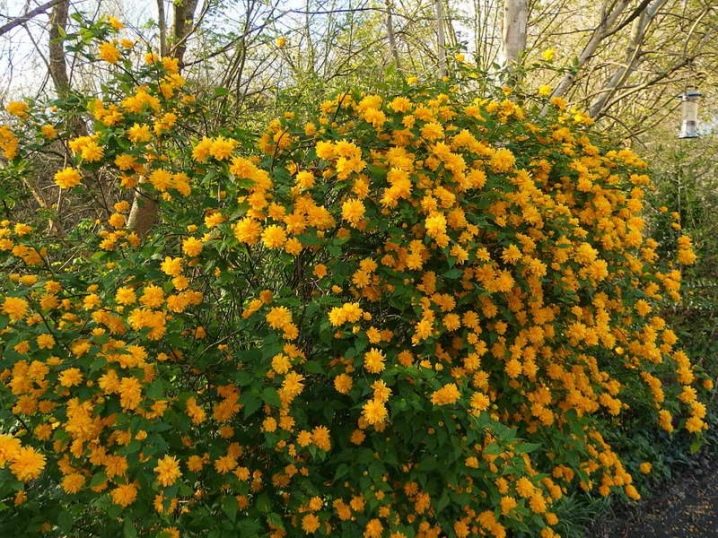
Not only the flowers of this plant, but also its leaves are distinguished by exceptional decorativeness.
They have an elongated oval shape, serrated at the edges, and their length is about 10 cm. Deep veins run across the entire leaf plate. The upper surface is smooth, the lower one is slightly pubescent. In the warm season, the foliage has a pale emerald color; with the arrival of autumn, the color changes to yellow.
Japanese kerria cannot be called a frost-resistant plant. In conditions of negative temperatures, the ends of branches or shoots can freeze through, up to the level of the snow cover. However, this perennial is famous for its intensive growth, therefore, with the arrival of spring, it quickly recovers. However, flowering is often poor after a harsh winter.
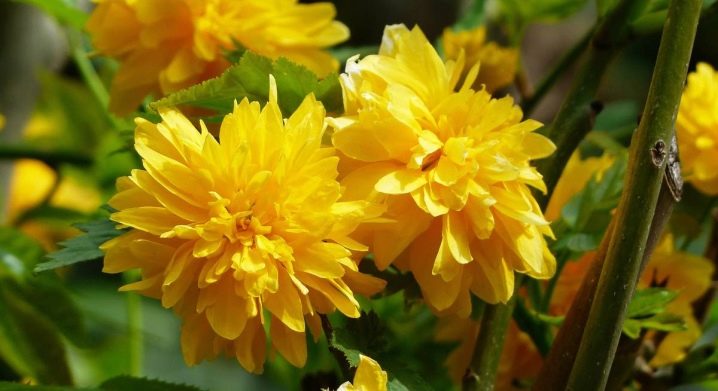
The undoubted advantage of such plants is their resistance to air pollution.
That is why it is often planted near factories, highways and other areas of increased gas pollution. The same feature makes the culture in demand in the landscaping of children's educational and medical institutions.
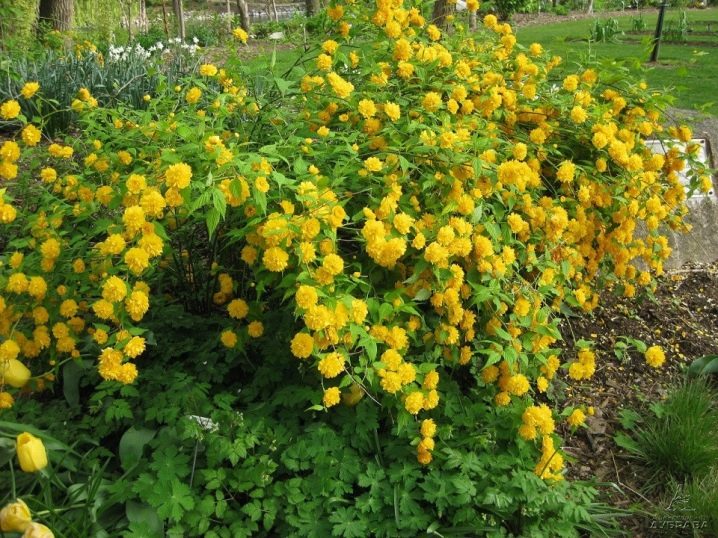
Varieties
There is only one kind of kerria - the Japanese kerria. In Russia, it is presented in several forms.
- "Pleniflora". An upright, profusely flowering, lush shrub. The branches are small, no more than 3 cm in diameter. Flowers are arranged one by one in the leaf axils or in groups of 2-3 buds.
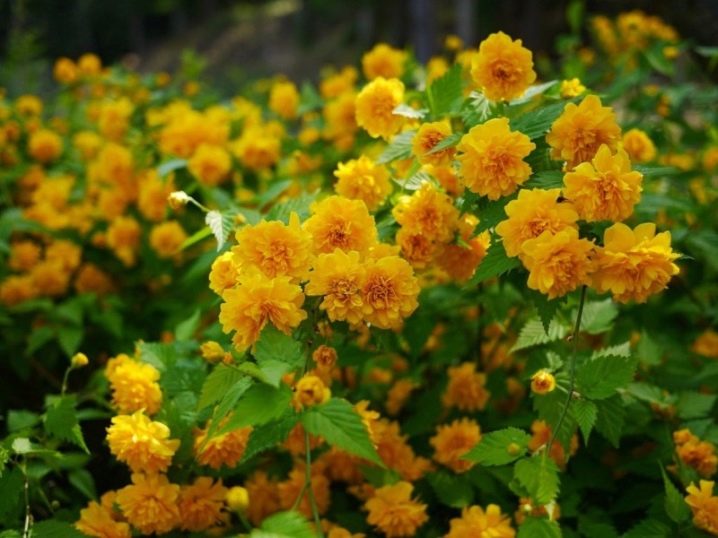
- Albomarginate. Varietal form, which is characterized by slow development. Variegated leaves give a special decorative effect to this shrub. The flowers themselves are simple and inconspicuous, outwardly similar to buttercups.
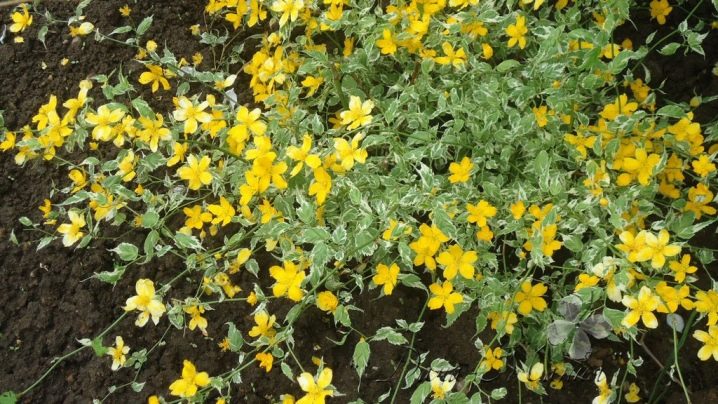
- "Picta Variegata". Graceful undersized shrub, decorated with variegated leaves with light spots and edging. The flowers are bright yellow and of a fairly simple shape.
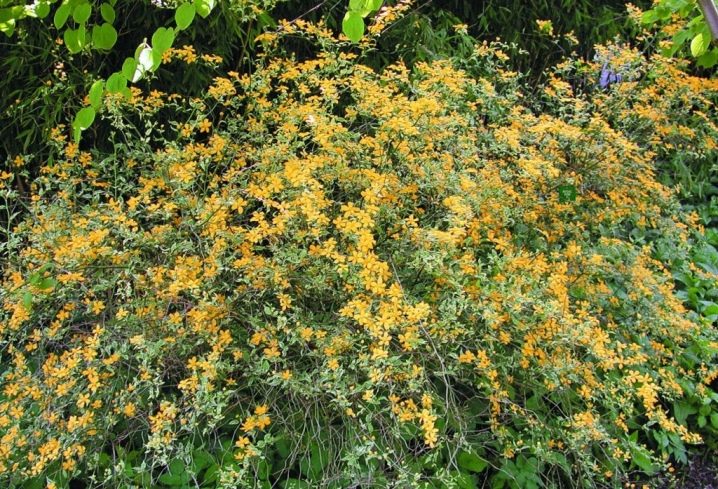
- Golden Guinea. This variety of kerria got its unusual name due to its large flowers. They are very similar in color and diameter to the British gold coin.
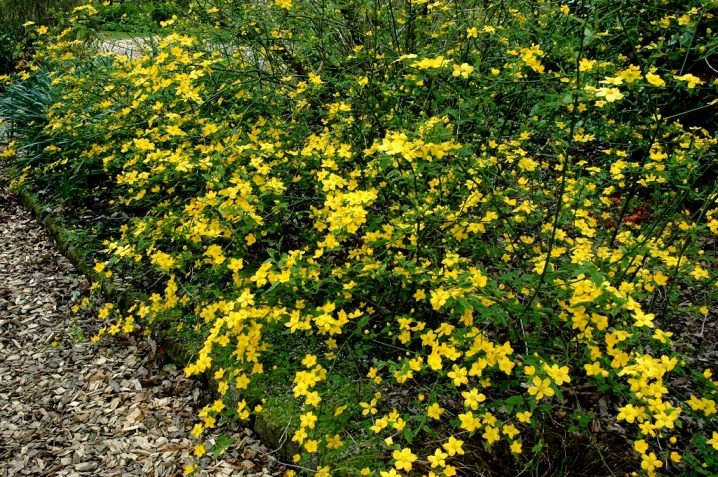
- Albiflora. for this subspecies, simple small flowers of white shades with five petals are typical. The leaves have a deep green color, they are arranged alternately on the branches. The subspecies can grow up to 2 m.
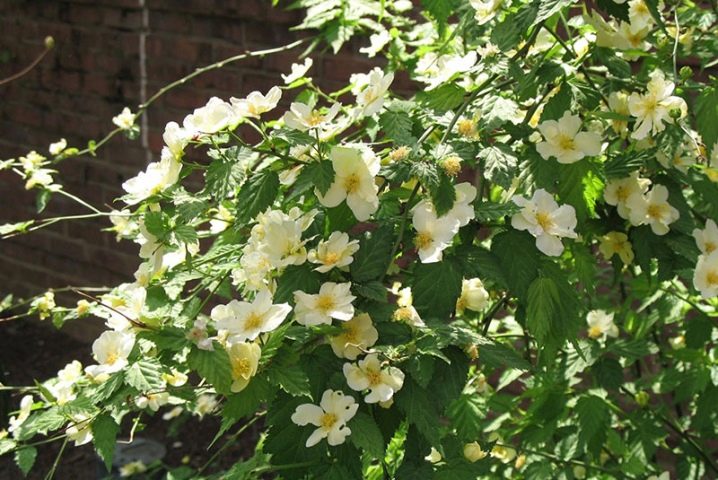
Slightly less often, domestic gardeners plant Japanese kerrias with simple yellow flowers, such as "Kin Kan" and "Simplex". The variegated varieties of "Aureovariyegata" will become a worthy decoration of the garden.

Landing
Kerria can be planted directly in open ground or pre-grown in container seedlings. In the first case, landing on a permanent site is carried out in the spring, immediately after the ground warms up to + 10-15 degrees. When planting in autumn, work is carried out in the first half of October, so that before the arrival of frost the plant has time to adapt to new conditions.
When growing a culture by seedlings, transplanting into open ground is carried out in any month.
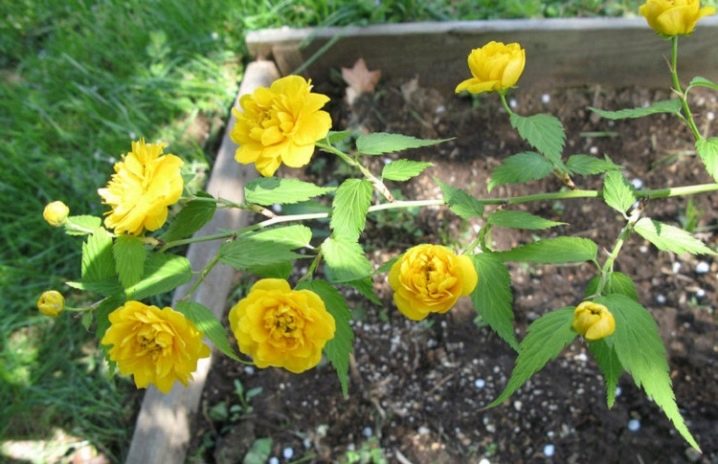
Kerria feels comfortable both in sunny areas and in shady places. Sometimes it is planted near large trees. This does not affect flowering in any way, as the buds on this shrub bloom long before the surrounding trees are enveloped in lush foliage. However, the flowering intensity will still be slightly lower compared to those shrubs that grow in open areas.
It should be borne in mind that kerria does not tolerate drafts. The fragile shoots of this plant are unable to withstand the gusts of wind. Culture can reveal its decorative beauty to the maximum only in a bright and protected place.
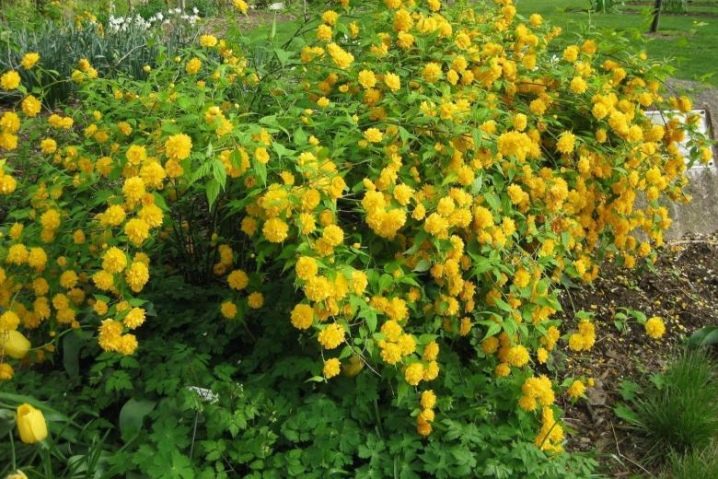
As for the substrate, it can be absolutely anything. However, this plant grows best of all on drained sandstones and loams. If the soil is too heavy, then before planting it is necessary to add river sand to it. Depleted substrates are additionally enriched with organic and mineral fertilizers.
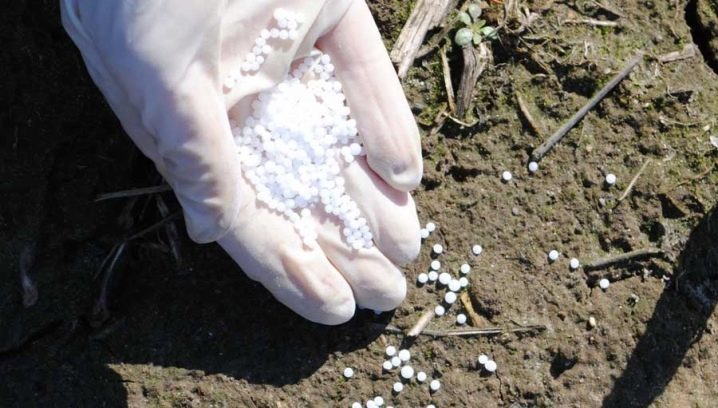
Planting involves several steps.
- In fertile moist soil, a planting hole is formed, the depth and width of which is 40-60 cm.
- A drainage layer is formed at the bottom and covered with a mixture of turf and humus. Add 6-8 tablespoons of the finished complex mineral fertilizer on top so that a small slide is obtained.
- Then the bush is placed in the center of the hole and the roots are gently straightened, after which they are sprinkled with a substrate so that the root collar is located at ground level.
- After that, the soil is lightly tamped and watered abundantly. To preserve moisture, sprinkle the place near the tree with a layer of mulch.
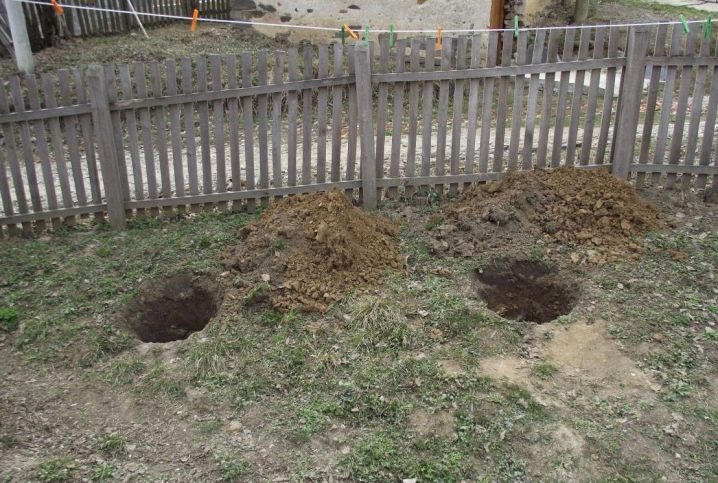
Care
After planting, the young plant needs proper care. Only if the basic rules of agricultural technology are observed, kerria quickly adapts, avoids diseases and becomes an excellent accent in landscape design.
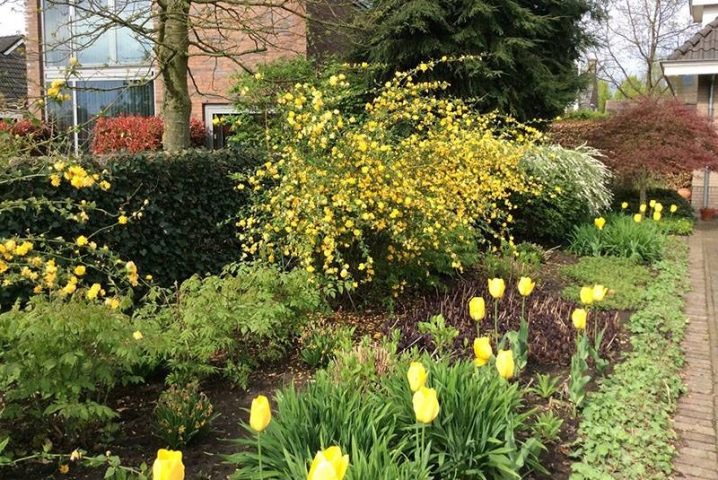
Watering and feeding
Exotic shrubs need daily watering in the first 3-4 weeks after planting. In this case, it is best to take the water soft, settled and always warm. After that, the number of waterings is reduced so that the layer of earth to a depth of 10 cm does not have time to dry out. Usually, natural precipitation is sufficient for this, although with prolonged drought, additional irrigation becomes necessary.
Particular attention should be paid to watering at the stage of bud formation: this is important for better flowering and building new shoots.
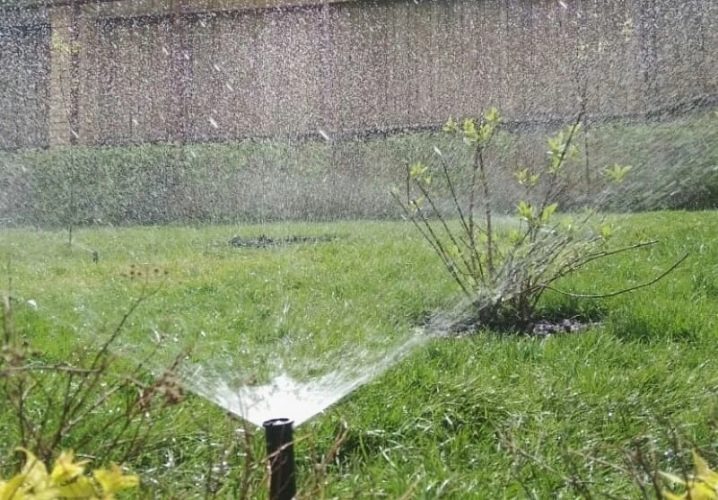
To keep moisture in the ground as much as possible, it is necessary to cover the area near the bush with mulch, for example, fallen leaves, straw, peat, crushed tree bark or needles.At the same time, this plant does not tolerate stagnant moisture, therefore, it is necessary to regularly loosen the ground and weed the weeds in a timely manner.
In the spring, immediately after the snow melts and pruning, the plant is fertilized. It is best during this period to use mullein diluted with water in a ratio of 1 to 10 or other organic matter. After 10-14 days, crushed wood ash is introduced at the rate of 150-200 g / m2 and compost, it is diluted in water in a ratio of 1 to 10. After the end of the first flowering, kerrias are fertilized with complex mineral compounds every two weeks.
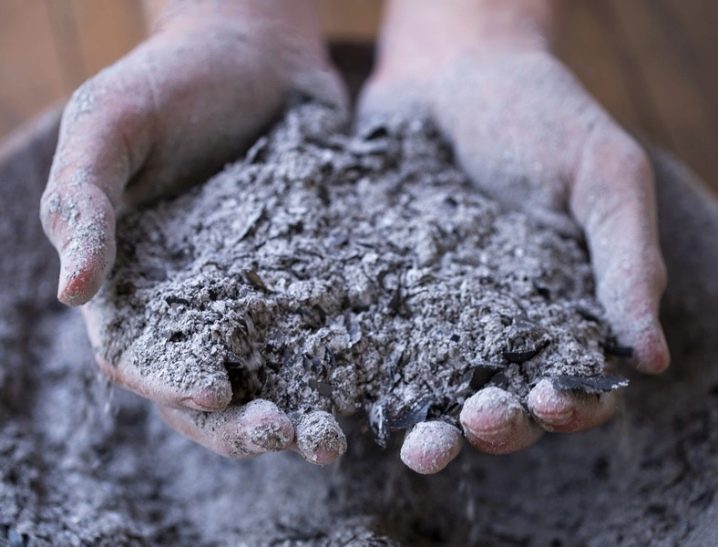
Pruning
An exotic crop has a high growth rate, so pruning is often done. In March, all broken, dried out and frozen branches are removed, young shoots are shortened by a quarter. The second pruning is done after the first flowering, at this time the old shoots are removed.
The last manipulation is carried out at the beginning of August, in which case the re-flowering will be more intense.
To make the plant look decorative, long shoots are usually shortened to the same length. Young shoots should not be touched. You also need to thin out the crown from time to time: these simple measures will allow you to form a compact, but very lush bush.
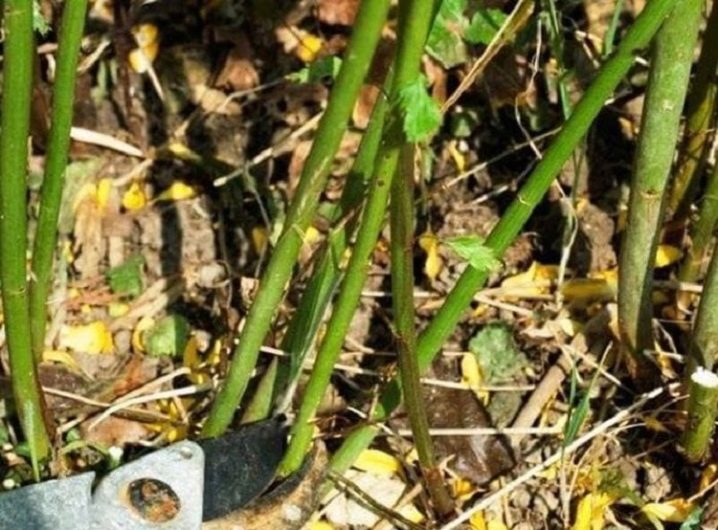
Post-flowering treatments
If the kerria seedling was grown in nurseries in Russia, then the plant will show good winter hardiness. After planting, the bushes will easily tolerate weather factors, including severe Russian frosts down to -30 degrees. However, in this case, we mean the preservation of the integrity of the root system, the aboveground part freezes under such conditions and often dies completely. However, with the arrival of spring, abundant young growth appears and the plants recover.
Those who do not want to waste precious time need to take a little care of the bush. To do this, the branches in early November are carefully pinned to the ground and covered with spruce branches from above. Immediately after the precipitation falls, the bush is covered with snow, such a shelter reliably protects the kerria and the branches do not suffer. In the spring, immediately after the snow melts, the shelter is removed.
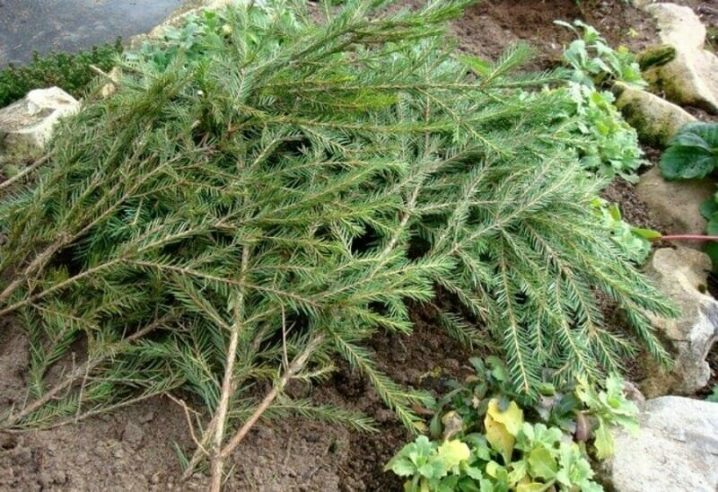
Important: it is undesirable to wrap the bush with a film, since in this case there is a high risk of rotting and stagnation of melt water. In such conditions, the roots of the plant begin to rot, the plant dies.
When growing exotic in the southern regions of our country, there is no need for such measures.

Reproduction
The easiest way to breed kerrias is to separate the cuttings. It is produced according to the following scheme:
- in the summertime, trenches 5-8 cm deep are dug not far from the parent bush;
- flexible lower branches are pressed to the ground, laid in a trench and fixed with brackets;
- 3-4 weeks after the appearance of new leaves, kerrias are sprinkled with a substrate so that only the tips of the branches remain on the surface;
- with the arrival of autumn, the development of the root system begins, and in the spring the grown layers are divided.
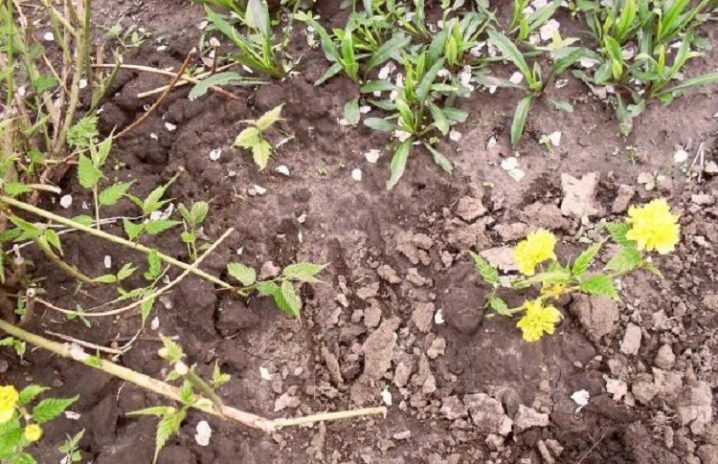
Reproduction by cuttings is no less popular; it involves several steps.
- In the first decade of April, lignified shoots are carefully separated, and in July - green ones, and they are used as planting material. In this case, at least two buds should form on the cuttings.
- The workpieces are planted in a shady, cool place in the greenhouse. It usually takes a lot of time to develop, build and strengthen the root system, so it is best to leave young bushes in a greenhouse for the winter.
- In May, the cuttings are moved into containers and brought into the house or another warm room. Landing in open ground is done every other season.
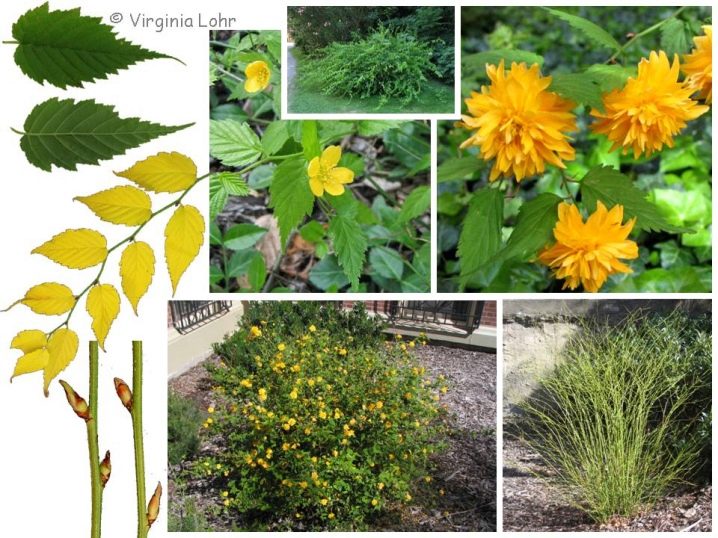
Alternatively, kerria can be propagated by offspring. In this case, the shoots are separated from the parent bush and planted separately.
When comfortable conditions are created, the root system quickly adapts and young bushes in a short time grow to a full-fledged adult plant.
Another breeding method is dividing the bush, it is often used when transplanting. In the course of the pick, the rhizomes are cleared of the ground and carefully divided into several parts with a pruner. In this case, each part should have powerful stems and well-developed roots. The plots are planted in the same way as the initial planting, after which they are watered abundantly.
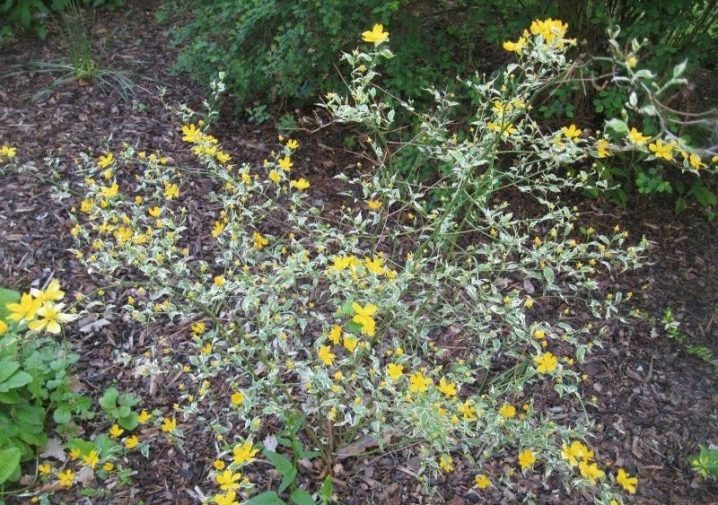
Diseases and pests
Kerria is one of the most resistant to diseases and pests of ornamental plants. Subject to all the rules for its content, it rarely encounters parasites and infectious diseases. In the rarest cases, the seedlings are attacked by a spider mite, most often this happens due to dry air, excessive dustiness and pollution of the foliage. Insecticides "Fitoverm" or "Fufanon" help to destroy the insect. In order to prevent further damage, it is necessary to regularly spray the plant, wipe the bushes with a damp cloth and, if possible, install a humidifier.

Use in landscape design
Kerria fits organically into any landscape composition. She is good both in a large group and in a solo fit. The plant has every chance to become a real highlight of a small garden and remain the center of attention in a large garden. Culture is often used when creating hedges, it is in demand when decorating front gardens and lawns, and it also looks harmoniously as a background array.
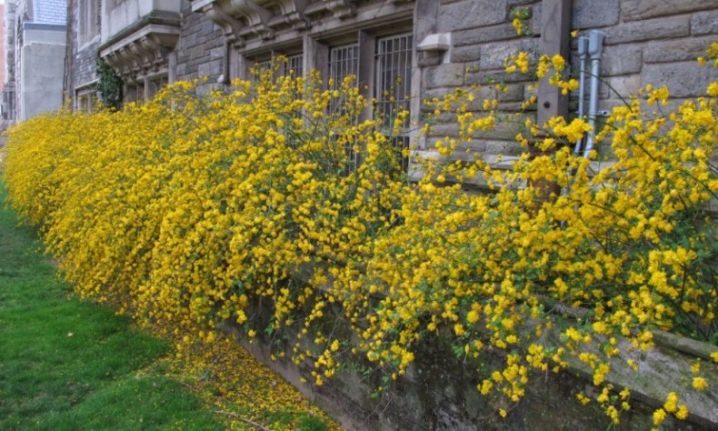
This lush flowering bush looks especially good against the background of ground cover. By the way, kerria can be planted not only in the open field. It grows and develops successfully in tubs, containers and stone flowerpots. You can put them in any corner of the garden, adding the necessary expressiveness to a particular area.
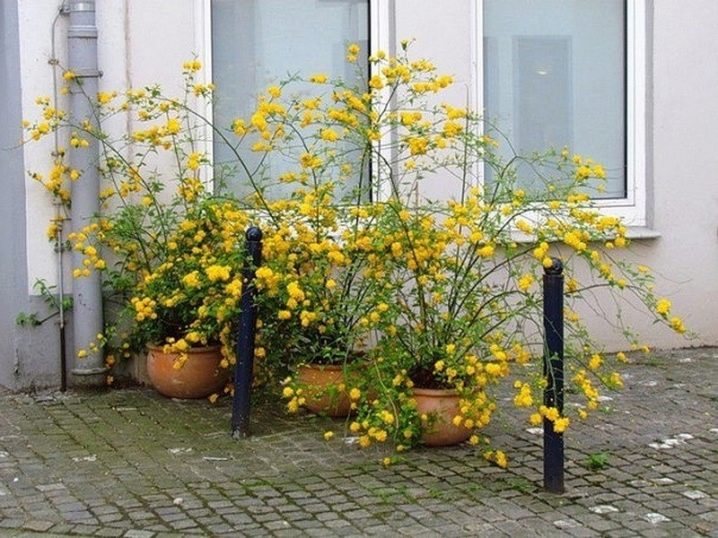
The most spectacular neighbors for Japanese kerrias are hazel, rhododendrons, freesia, spirea and other landscape shrubs. The tandem with decorative deciduous crops looks very good: phlox or periwinkle. The combination of this shrub with spring forget-me-nots, daffodils and tulips looks very gentle.
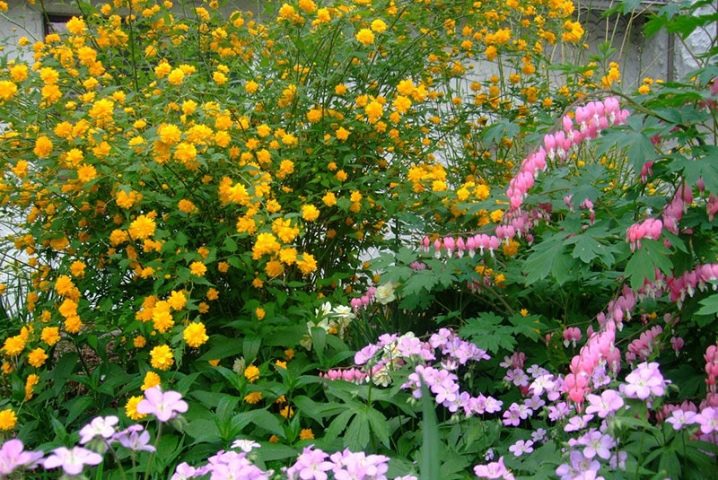
Kerria is one of the most beautiful plants. It is distinguished by colorful and abundant blooms that can beautify any landscape. At the same time, the content of the culture is not particularly difficult: you just need to periodically water the shrub, prune and fertilize from time to time. If these simple conditions are observed, then the exotic will delight its owners for many years.
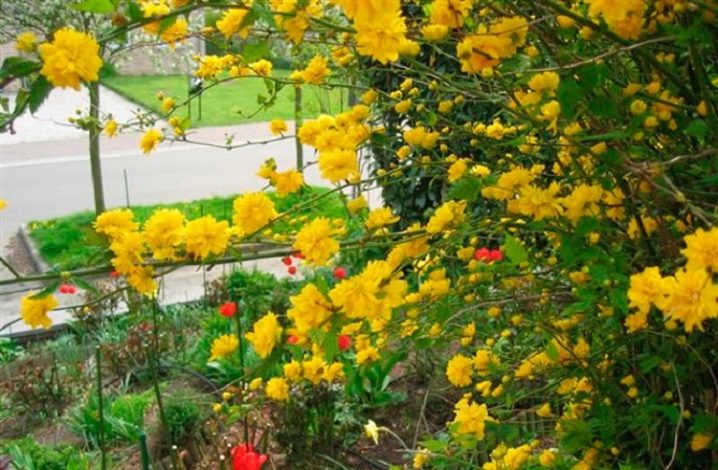



































































The comment was sent successfully.